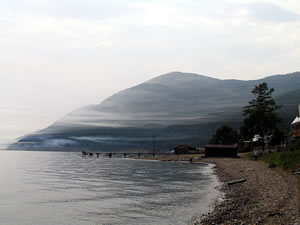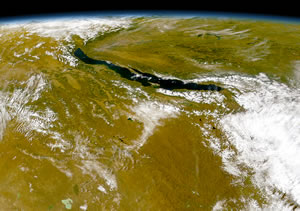Lake Baikal in Siberia is the oldest lake, as well as the deepest lake on Earth.
It is 25 million years old.
At its maximum depth, Lake Baikal is 1,642 meters (5,387 feet). It is 636km (395mi) long with an average width of 48km (30mi).
Its surface area is about 31,500sq.km (12,200sq.mi), only two fifths the surface area of Lake Superior in North America. However, it is four times as deep.
 Lake Baikal contains one fifth of all the fresh water in the world - 23,000cub.km (5,500cub.mi). More than 300 rivers pour their waters into Lake Baikal but only one, the Angara, drains it.
Lake Baikal contains one fifth of all the fresh water in the world - 23,000cub.km (5,500cub.mi). More than 300 rivers pour their waters into Lake Baikal but only one, the Angara, drains it.
Formation of Lake Baikal
There are gigantic fault lines in the Earth's crust in the center of Asia. 80 million years ago, tremendous upheavals and earthquakes widened these faults. A portion of the Earth's crust collapsed and formed a deep, sheer-sided chasm, known as a graben.
At the same time, mountain ranges were pushed up on either side. The graben remained predominantly dry, since the water draining into it soon evaporated.
25 million years ago, the climate turned wetter. Rainfall outstripped evaporation and the lake began to be filled.
Lake Baikal continues to grow
 In 1862, a massive earthquake struck the area around the mouth of the Selenga River, which provides the lake with 50 per cent of its water, and severed roughly 175sq.km (77sq.mi) of land from the shore. Water rushed in from the lake and created a new bay, known as Proval Bay.
In 1862, a massive earthquake struck the area around the mouth of the Selenga River, which provides the lake with 50 per cent of its water, and severed roughly 175sq.km (77sq.mi) of land from the shore. Water rushed in from the lake and created a new bay, known as Proval Bay.
The whole of Asia is being reshaped. As the land continues to slip beneath Lake Baikal, it is opening up a still greater chasm, which, in a few million years, will link up with the Arctic Ocean and divide Asia into two.
Life in Lake Baikal
Lake Baikal has provided constant living conditions for more than half of its 25 million years. Therefore, it contains a huge variety of endemic life forms.
Around 35 percent of the Lake Baikal's 600 plant species and 65 per cent of its 1,500 animal species are unique to its waters.
All Baikal's creatures depend on the food and oxygen that algae and plankton produce in the top 50m (165ft) of water.
Animals living in the depths of the lake either feed, like shrimps, on the detritus falling from the surface layer, or else eat each other.
All but one of the lake's 255 species of freshwater shrimp - a third of the world's total - can be found in its deep waters. Of the 35 different genera of freshwater shrimp, only one can be found elsewhere in the world.
More than 50 species of fish, half of them unique to the lake, inhabit Baikal's waters.
The largest fish is the sturgeon, which grows 1.8m (6ft) long and weighs more than 100kg (2201bs).
The golomyanka is a completely transparent, scaleless fish. It grows to about 20cm (8in) in length and accumulates about a third of their body weight as oil.
At night, golomyanka migrate from as far down as 500m (1,650ft) to the surface waters in order to feed on the minute creatures that comprise the zooplankton. The golomyanka must descend again before the temperature of the lake rises above 7°C (45°F), otherwise their oils begin to liquefy and they die.
Female golomyanka do not lay eggs. They give birth to as many as 3,000 live larvae.
The white, salmon-like omul is a local Baikal delicacy. Forming up to 70 per cent of the commercial fish catch of the lake, the omul grows 30cm (12in) long and weighs around 454g (16oz). These fish remain inactive until the summer when the temperature of the lake's surface water rises to about 16°C (60°F). At dusk and at dawn, schools of omuls feed voraciously on the zooplankton, which swim to and from their regular nighttime feed at the surface.
The Baikal seal, or nerpa, is unique to Lake Baikal. The nearest relative of the Baikal seal is the Arctic seal, which lives 3,200km (2,000mi) away in the Arctic Ocean. There is no evidence of an ancient sea in the region, so the Baikal seal must have travelled to the lake against the currents of the Yenisei/Angara river system. It is believed that this journey took place 12,000 years ago.
The Baikal seal survives the winter, when the lake is frozen for four or five months with ice that can be as much as 1.2m (4ft) thick, by making air holes in the ice, which it keeps open by gnawing them from below.
The seal lives among the rocky crags at the northeastern end of the lake in summer, taking advantage of the large amount of fish available for consumption.